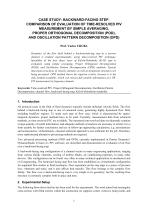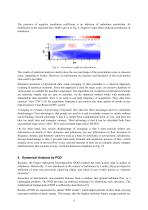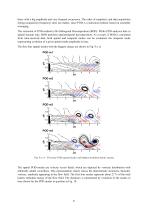
Catalog excerpts

CASE STUDY: BACKWARD-FACING STEP. COMPARISON OF EVALUATION OF TIME-RESOLVED PIV MEASUREMENT BY SIMPLE AVERAGING, PROPER ORTHOGONAL DECOMPOSITION (POD), AND OSCILLATION PATTERN DECOMPOSITION (OPD) (Empty line size 14) Prof. Vaclav URUBA (Empty line size 12) Dynamics of the flow field behind a backward-facing step in a narrow channel is studied experimentally, using time-resolved PIV technique. Instability of the free shear layer of Kelvin-Helmholtz (K–H) type is evaluated, using simple averaging, Proper Orthogonal Decomposition (POD), and Oscillation Pattern Decomposition (OPD) methods. Typical time-mean structures of velocity statistics as well as dynamical structures are being presented. OPD method shows far superior results, because it is the only method available, which can extract full useable information of a TRPIV measurement in frequency domain. Keywords: Time-resolved PIV, Proper Orthogonal Decomposition, Oscillation Pattern Decomposition, channel flow, backward facing step, Kelvin-Helmholtz instability. 1. Introduction All practical cases in the field of fluid dynamics typically include turbulent velocity fields. The flow behind a backward facing step is one of canonical cases, generating highly dynamical flow field, including backflow regions. To study such type of flow case, which is characterized by spatiotemporal dynamics, proper methods have to be used. Currently, measurement data from advanced methods, as time-resolved PIV, are available. The measured time-resolved data set inherently contains a large quantity of useful information, and adequate methods of analysis are necessary to extract it in a form useable for further conclusions and use in follow-up engineering calculations, e.g. aeroelasticity and aeroacoustics. Unfortunately, classical statistical approach is not sufficient for the job. Therefore, more sophisticated alternative processing methods are required. Two advanced processing methods (POD and OPD), currently implemented in Dantec Dynamics’ DynamicStudio Version 4.x PIV software, are described and demonstrated on evaluation of air flow over a backward-facing step. A backward-facing step configuration of a channel occurs in many engineering applications, ranging from various fluidic elements, cooling of turbine blades, air conditioning pipelines, to many other devices. This configuration can be found very often in many technical applications in mechanical and civil engineering. The backward facing step flow has been established as a benchmark configuration for separated flow studies in fluid mechanics. Flow separation on the step edge is a source of pressure loss, vibrations and noise, and it also affects heat transfer. This flow belongs to the complex flow family. The flow over a backward-facing step is very simple in its geometry, but the resulting flow structure is extremely complex both in space and time. 2. Experimental Setup The following blow-down facility has been used for the experiments. The wind tunnel had rectangular cross-section with filled corners within the contraction (to suppress corner vortices), honeycomb, and
Open the catalog to page 1
a system of damping screens followed by contraction with contraction ratio 16. The area of the test section input was 0.25 m high and 0.1 m wide. The time mean velocity differed from homogeneity in planes perpendicular to the tunnel axis in the order of tenths of percent. The channel downstream the backward facing step was 1 m long. The step was placed close to the channel inlet. In the channel inlet, the boundary layer thickness on the walls in the step position was about 3 mm, the step height was h = 25 mm. Velocity in the inlet on the step was Ui = 7.5 m/s and natural turbulence level...
Open the catalog to page 2
Fig. 2 – Snapshots of vorticity distribution Vorticity distributions in Fig. 2 shows free shear layer with negative (clockwise) vorticity. Behind the step, within then so called zone of recirculation, presence of large amount of small vortical structures is visible, with both positive and negative orientations. The topology of this zone is very complex and dynamical in nature. Such behavior is typical for strongly turbulent flow. 3. Statistical Analysis by Averaging Evaluation of first and second order statistics (mean and variance or covariance) is a classical approach to evaluation of...
Open the catalog to page 3
[0.4; -0.9] position. Please note that this time-mean picture never exists in the instantaneous level, in any particular time moment. Fig. 4 – Mean velocity field vectorlines The generally accepted definition of backflow region is based on presence of negative value of streamwise (x-direction) mean velocity component. The back-flow region is clearly visible in Fig. 5, where only mean streamwise velocity component is plotted. Back-flow region of negative streamwise velocity is depicted in blue. Fig. 5 – Streamwise mean velocity component distribution The vertical spanwise (y-direction) mean...
Open the catalog to page 4
The presence of negative correlation coefficient is an indicator of turbulence production. Its distribution in the measured flow field is given in Fig. 8. Negative value (blue) indicates production of turbulence. Fig. 8 – Correlation coefficient distribution The results of statistical analysis clearly show the size and shape of the recirculation zone in classical sense, capturing its border. However, no information on structure and dynamics of the recirculation zone itself is provided. Statistical treatment of dynamical data using averaging of data ensemble is a classical approach,...
Open the catalog to page 5
those with a big amplitude and very frequent occurrence. The order of snapshots, and data acquisition timing (acquisition frequency) does not matter, since POD is a statistical method, based on ensemble averaging. The extension of POD method is Bi-Orthogonal Decomposition (BOD). While POD analyses data in spatial domain only, BOD performs spatiotemporal decomposition. As a result, if BOD is calculated from time-resolved data, both spatial and temporal modes can be evaluated, the temporal mode representing evolution of a given spatial mode amplitude in time. The first four spatial modes with...
Open the catalog to page 6All Dantec Dynamics A/S catalogs and technical brochures
-
F-Q-480
2 Pages
-
F-Q-400TCT
2 Pages
-
Q-400 μDICTM
2 Pages
-
5 Beam 112mm probe
2 Pages
-
LabVIEW Toolbox for CTA
2 Pages
-
Least Squares Matching (LSM)
3 Pages
-
DynamicStudio Base Package
5 Pages
-
Flow Field
8 Pages
-
HiSense 600 series
2 Pages
-
FlowSense EO
4 Pages
-
HiSense Zyla
2 Pages
-
ComfortSense Mini
4 Pages
-
DISATAC Tachometers
56 Pages
-
Laser Doppler Anemometry
8 Pages
-
Probes for hot-wire anemometry
25 Pages
-
FlowExplorer compact LDA
2 Pages
-
DynamicStudio
8 Pages
-
Spray Diagnostics Solutions
8 Pages
-
Wind Turbine Optimization
8 Pages
-
Laser shearography (Q-800)
2 Pages
-
Q-501 Real Time Mode Monitor
2 Pages
-
PDA systems
8 Pages








































